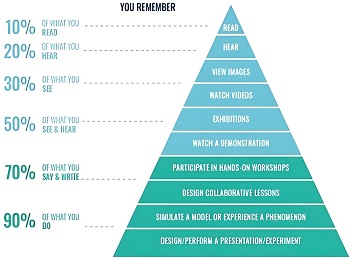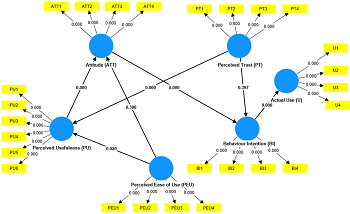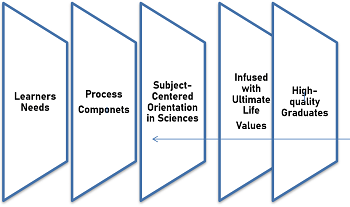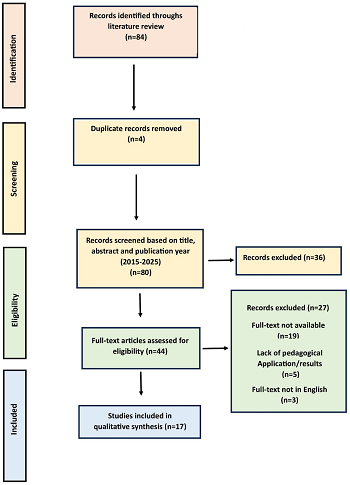Vol 5 No 2 (2025)
Research Article
Experiences of Developing Conceptual Understanding of 3D Shapes through Audio-Visual Aids
This study explores grade X students’ experiences of developing a conceptual understanding of 3D shapes through audio-visual aids in the Nepalese context. Teachers are using traditional teaching strategies in which they mostly rely on textbooks and lecture-based instructions, and these pedagogical approaches can disengage students, obstruct their mathematical understanding conceptually, and hinder implementation in real-life situations. The study employs a qualitative narrative inquiry method to gather and explore the data. Two teachers having long-term teaching experiences and two students studying in secondary schools are chosen. In-depth interviews are taken to evaluate the impacts of audio aids like YouTube, GeoGebra, Microsoft Excel, Khan Academy, etc., on students' learning experiences; data is transcribed and discussed thematically. The findings of the study show that the proper use of audio-visual resources in mathematics teaching helps to enhance deeper mathematical understanding. Audio-visual aids improve students' active engagement in mathematics classrooms. It also bridges the gap between complex mathematical concepts and their applications in real-life scenarios. Incorporating audio/visual assets in mathematics classrooms can revolutionize the learning environment, encouraging students' active participation and ensuring long-term conceptual mastery. This study underlines the experiences of developing a conceptual understanding of 3D shapes through audio-visual aids. The study suggests that policymakers should equip every school with technological tools and ensure their proper use in the classrooms.
Trust and AI Adoption for Mobile Learning in Higher Education: Evidence from Tanzanian Universities
Artificial intelligence (AI) is transforming practices across multiple domains, including education, where adaptive teaching methods are enhancing learning processes. This study examines whether trust influences AI acceptance in higher learning institutions (HLIs) in Tanzania. Using a quantitative approach based on structural equation modeling (SEM) with data from 215 respondents, we extended the Technology Acceptance Model (TAM) by integrating trust as an external variable. While the model was generally supported, perceived trust did not emerge as a significant predictor of behavioral intention to use AI in Tanzanian HLIs. These findings provide theoretical and policy insights for AI adoption in higher education and suggest avenues for future research.
Digital photographs are commonly used for science instruction since they can facilitate meaning-making and can draw students' interest and attention. However, it appears valuable to explore teachers' own creations of digital photographs, e.g. by using their portable mobile phone devices, to illustrate scientific phenomena as well as to create metaphorical representations of these phenomena, which this study calls 'photographic metaphors'. In this direction, this study qualitatively examined preservice preschool teachers' (n = 42) artistic photographs and photographic metaphors. Furthermore, it examined teachers' views on using such an arts-based approach through qualitative content analysis of their questionnaire reflections. The findings revealed that teachers created a variety of photographic metaphors having linguistic and conceptual features. Furthermore, they found such an approach engaging and effective for science teaching. However, challenges often arose since teachers created inaccurate or vague metaphors in several instances. The findings inform teacher education designers in implementing arts-based approaches in science, specifically through artistic photography.

Pages 1575-1583
It is widely known that children nowadays use the Internet for communication, entertainment, and educational purposes. Parents try to control their children's Internet use in various ways. Within this context, an investigation was carried out into the practices used by parents of primary school children to monitor Internet usage, as well as the impact of this usage on their academic performance. Through qualitative research and interviews with eight parents who were also educators, several conclusions were drawn regarding children's Internet use and its effect on school performance. The results of the present study showed that parents monitor their children's online activity by observing the websites they visit and try to limit the time they spend on the Internet. The responses indicated that the more time children spend online, the lower their academic performance tends to be. Moreover, the greater the parental control over Internet use, the higher the academic performance of primary school children.
This study explores postgraduate students' perceptions and practices regarding Artificial Intelligence (AI) tools in distance education at the Hellenic Open University (HOU). Conducted over two academic years (2023--24 and 2024--25), it examines students' familiarity with AI, perceived benefits and challenges, and opinions on ethical integration. Quantitative data were gathered via an online questionnaire from a sample of 373 students enrolled in two M.Sc. programmes. Results show that although students are somewhat familiar with AI, actual usage remains limited, mainly due to a lack of necessity, inadequate training, and institutional support. Those who use AI report benefits in research efficiency, time management, and feedback. However, concerns about reliability, academic integrity, and ethical ambiguity remain. Students strongly support establishing a regulatory framework, providing training for both students and educators, and modifying curricula to promote responsible use. The study underlines the importance of institutional preparedness and critical digital literacy as key factors for effective AI integration. Implications for educational practice, policy development, and future research are discussed, emphasising the need for a balanced, ethical, and pedagogically sound approach to AI in distance learning.
This study analyzes the effectiveness of an Electronic Student Worksheet (E-LKPD) integrated with the local wisdom of the traditional egrang game in enhancing students’ critical thinking skills in physics learning. The E-LKPD was developed using the ADDIE model (Analyze, Design, Develop, Implement, Evaluate) and tested with a one-group pretest–posttest design involving 35 students in Class XI A3. Effectiveness was measured through normalized gain (N-Gain) analysis of students’ critical thinking test scores. Results showed an average N-Gain of 0.81 (high category), with 97% of students achieving substantial improvement. Integrating the egrang game as a contextual learning medium helped students link real-life experiences with physics concepts, fostering deeper understanding and active engagement. These findings indicate that the developed E-LKPD effectively improves critical thinking skills while supporting meaningful, culturally relevant, and student-centered learning aligned with 21st-century educational demands.
Computational Thinking (CT) has been slowly being integrated into early education curricula as a critical skill for 21st-century learners. However, implementation of fully developed curricula devoted to CT development the corresponding motivational aspects for young learners, particularly when using pedagogical strategies like gamification, are scarce, especially when it comes to their long-term effects. This study investigates the long-term impact of the "Coding as Another Language" (CAL) with ScratchJr and integrated gamification elements through the ClassDojo platform on the CT skills and motivation in early childhood education. In this study, we employed a quantitative, semi-experimental approach measuring CT skills utilizing a pre-test and post-test approach and a brief summative assessment test. Also, a motivational questionnaire was utilized post-intervention. The sample consisted of 12 second-grade students over an entire school year. The findings revealed a statistically significant improvement in students' CT development. Furthermore, students reported significant high levels of self-efficacy, grade, self-determination, and intrinsic motivation suggesting that the gamified, project-based approach successfully fostered sustained engagement and confidence in a collaborative environment. This research contributes valuable insights into the successful implementation of long-term, gamified coding programs for young children, demonstrating that such approaches can significantly enhance both cognitive skills and key motivational aspects.
This study investigates the pedagogical potential of combining artificial intelligence (AI) tools with drama-based strategies in digital learning environments within primary education, focusing on the development of students' critical thinking skills. To this end, twelve original teaching scenarios were designed and implemented in a sixth-grade classroom, blending the use of AI-powered online applications with experiential drama techniques. These digital tools, accessed through computers and portable devices available in the classroom, supported learners in generating content, exploring multiple perspectives, and engaging in reflective dialogue. The intervention employed a mixed-methods research design and was conducted with a convenience sample of 46 11-year-old students attending an urban public primary school. Data were collected through pre- and post-intervention questionnaires, classroom observations, and focus group interviews. Quantitative results indicated a measurable improvement in students’ ability to analyse, evaluate, and justify ideas, while qualitative data provided evidence of increased engagement, collaborative interaction, and deeper metacognitive awareness. The findings suggest that the purposeful integration of AI into classroom practice, when combined with creative and participatory learning methodologies such as drama, can contribute meaningfully to the cultivation of critical and reflective thinking in young learners. Moreover, this interdisciplinary approach was found to support inclusive participation by offering varied entry points for student expression and understanding. The study highlights the relevance of reimagining digital or mobile-supported pedagogy through the lens of artistic and dialogic learning, particularly in educational contexts that aim to equip students with essential 21st century skills. It also opens pathways for further research into how AI enhanced environments can foster equity, creativity, and cognitive engagement in primary classrooms.
The development of digital technology has significantly simplified remote interaction and communication. Mobile phones have become an integral part of everyday life, including their use in gospel communication. This study explores how theology students in Indonesia utilize mobile phones for gospel communication, employing qualitative research methods. Data were collected via a Google Form containing open-ended questions, completed by 154 theology students from various provinces across Indonesia. The data were then analyzed using Microsoft Excel and NVivo 12 Plus software through stages of data reduction, grouping with pivot commands, meaning condensation through thematic analysis, and interpretation. The findings indicate that mobile phones play a significant and effective role in gospel communication among theology students. They enable users to share information and communicate easily, thereby expanding the reach and overall impact of the Gospel message. This research contributes to the development of effective strategies for using mobile phones and social media in theological education and offers a clearer understanding of how theology students in Indonesia engage with these technologies.
Fostering Critical AI Literacy through a Decolonial Use of ChatGPT in ESL/EFL Classrooms
This article examines the potential and risks of integrating AI tools, such as ChatGPT, into ESL/EFL classrooms from a decolonial perspective to enhance vocabulary instruction. Centering on eighteen English words from an English textbook designed for school education, the study examines how ESL/EFL vocabulary can be taught using ChatGPT to encourage students to engage with and critically reflect on its outputs. Employing the method of strategic prompting and qualitative content analysis of ChatGPT responses, the article explores how students' first languages (L1) can be meaningfully connected to English (L2) using ChatGPT as a pedagogical tool, particularly within a multilingual and multiethnic educational context. The study demonstrates that a decolonial approach to AI tools, such as ChatGPT, can enhance ESL/EFL pedagogy by promoting linguistic inclusivity and fostering critical AI literacy among students. Hence, the article contributes to the emerging conversations on decolonial ESL/EFL pedagogy and critical AI literacy by positioning AI tools, such as ChatGPT, not as a neutral source of information, but as a tool to enhance language learning in diverse linguistic contexts with a higher degree of human intervention.
Writing can be a challenging task for many people. Developing ideas, organizing them into an outline, spelling words, creating sentences with descriptive adverbs and adjectives, and making edits for a finessed final copy require an ability to manage these tasks concurrently to help make the ideas and phrases flow into a coherent text. For educators as well as governmental departments of education who create and manage yearly testing, there are many options for how writing can be assessed; assessment choices play a part in defining students who struggle with writing. This conceptual article discusses the challenges that students who struggle with writing face, technology tools that can help and how assessment of students' skills can be designed and applied to progress monitor (assess) writing content and quality over time. The conclusions of this article emphasize the benefits of employing research/evidence-based practices for writing with technology tools. The implications are that students who struggle with writing can benefit from step-by-step (strategy) instruction, progress monitoring their written content and quality skills as intervention programming sessions progress, and employing technology tools to help with idea generation, spelling, grammar/syntax, and revising ideas.
This study explores the impact of a blended learning approach on fifth-grade students’ conceptual and procedural knowledge of fractions. A quasi-experimental design was implemented with 130 fifth grade students from public primary schools in socio-economically homogeneous areas of Heraklion, Crete (control group: n = 64; experimental group: n = 66). The intervention combined mobile-accessible H5P interactive tasks designed on e-Me learning platform, featuring dynamic environments in Geogebra, with hands-on activities using manipulatives and student-constructed models. Emphasis was placed on collaborative learning and verbal articulation of reasoning. Wilcoxon signed-rank tests revealed significant within-group improvements in both groups. However, the experimental group showed greater gains. Mann–Whitney U tests confirmed that improvements in conceptual and procedural knowledge were significantly higher in the experimental group (p = 0.003 and p = 0.008, respectively), with moderate effect sizes. These findings suggest that the blended learning approach substantially supports fraction learning by bridging conceptual and procedural aspects of knowledge. The use of browser-based, open-source software proved effective in creating personalised, engaging learning experiences. This study contributes to the growing discussion on technology-enhanced fraction learning by presenting a flexible, learner-centered approach that empowers teachers to design contextually responsive fraction learning experiences.
In this digital era, mobile technology has transformed the education system and made mobile learning media increasingly important, especially in physics education as a complex discipline. Mobile-based learning media, such as physics simulation applications accessed via mobile phones, interactive learning videos via tablets, and mobile learning platforms, have been shown to help students understand abstract and complex physics concepts. However, there is still a gap in the literature regarding how students' preferences for mobile-based learning media affect their physics learning competence and motivation in the context of physics education. This study aims to investigate the relationship between students' preferences for mobile-based learning media, physics competence, and learning motivation in physics learning. This study used a quantitative design with a survey method to collect data from 54 high school students in West Sumatra Province regarding their preferences for various types of mobile-based learning media in physics learning. Data were analyzed using multiple regression to determine the relationship between the variables studied. The results showed that students' preferences for mobile-based learning media had a significant positive impact on physics learning competence and motivation. The findings of the study also showed that students' preferences for PhET simulations accessible via smartphones, mobile-based educational social media applications, and physics learning videos had a significant influence on various aspects of students' physics competence and learning motivation. However, the impact varies depending on the type of learning media preferred and the pattern of students' mobile device usage in physics learning. This study provides valuable insights for physics education practitioners to improve students' learning experiences by considering students' preferences for mobile-based learning media. The implications of this study suggest that understanding and accommodating students' preferences for mobile-based learning media can significantly improve physics competence and learning motivation, thereby improving students' overall learning outcomes.
This study aimed to improve cadets’ learning activity and outcomes in basic mathematical concepts within the Applied Mathematics course through the implementation of the Electronic Mind Mapping (E-Mapping) method. The research was conducted in the Ship Machinery Study Program and involved 26 cadets who had previously taken the course. A classroom action research approach was employed, consisting of three cycles. Each cycle included a pre-test to assess initial abilities, delivery of instructional material, and task implementation using the E-Mapping method. A post-test was then conducted to evaluate cadets’ understanding and learning outcomes. In this study, E-Mapping was facilitated through mobile devices—primarily smartphones—using the SimpleMind and Canva applications. These tools enabled cadets to create, edit, and visualize mind maps in a flexible and interactive manner. The mobile-supported nature of these platforms allowed cadets to access their mind maps anytime and anywhere, enhancing the flexibility, accessibility, and autonomy of their learning. This approach empowered cadets to engage with mathematical concepts beyond the constraints of classroom time, thereby deepening their understanding. The findings revealed that the use of E-Mapping significantly enhanced cadet learning outcomes, as evidenced by increased levels of learning activity and higher average post-test scores. Positive learning activity improved progressively across the cycles: 30.77% in Cycle I, 66.66% in Cycle II, and 82.05% in Cycle III. Similarly, the average post-test score increased from 64.35 in Cycle I to 73.46 in Cycle II, and 82.12 in Cycle III. The study concluded that the E-Mapping method significantly improved both cadet learning activity and outcomes in the Applied Mathematics course. This improvement indicated that E-Mapping made a meaningful contribution to strengthening cadets’ understanding of fundamental mathematical concepts—such as algebra, trigonometry, and number theory—which are essential for applying mathematics in the field of ship machinery engineering. By enabling the visualization of interconnections among concepts, E-Mapping helped cadets systematically organize and integrate knowledge, thereby facilitating the comprehension of abstract and complex material.
Review
AI-Driven Pedagogical Leadership in Mobile and Adaptive Learning Environments
This conceptual and comparative study examined how pedagogical leadership can guide the integration of AI-driven mobile learning to promote adaptive and sustainable education. Drawing on international cases from Indonesia, Southeast Asia, Africa, and Europe, it identifies leadership strategies that align AI innovation with ethical and humanistic principles. The proposed framework highlights how moral integrity, visionary direction, and teacher competence enable the responsible adoption of mobile and generative AI tools for personalized and ubiquitous learning. The study contributed to advancing global discourse on AI-enabled mobile learning leadership and its implications for educational policy and practice.
This article undertakes a systematic review of the educational integration of the BBC micro:bit in primary education. Using the PRISMA methodology as a framework, empirical studies published in the past decade (2015–2025, as of August) were identified through Scopus and through supplementary searches in Google Scholar. Three additional studies were retrieved from Google Scholar to ensure broader coverage. In total, seventeen studies met the inclusion criteria and were subjected to thematic analysis. The findings indicate that the BBC micro:bit facilitates the development of students’ computational thinking, creativity, problem-solving skills, and collaborative abilities, while nurturing their autonomy, ecological awareness, and learning engagement. Effective pedagogical strategies-including STEAM activities, project-based learning, and physical computing--were commonly employed. This review also addresses methodological limitations of the included studies and emphasizes the necessity of further longitudinal research to fully unlock the educational potential of the micro:bit.
Generative AI in Pre-Service Science Teacher Education: A Systematic Review
Despite the increasing adoption of Generative Artificial Intelligence (GenAI) in education, there is a lack of comprehensive reviews on how GenAI is being utilized within Pre-Service Teachers (PSTs) in science. This systematic literature review (SLR) aims to address this gap by examining the extent and nature of GenAI integration in future science teachers' preparation programs. Using the PRISMA (Preferred Reporting Items for Systematic Reviews and Meta-Analyses) methodology, 21 peer-reviewed empirical studies published between 2022 and 2025 were identified and analyzed through qualitative thematic synthesis. The analysis addresses three research questions: 1) the extent to which GenAI is used in the curriculum of PSTs in science education; 2) how PSTs use GenAI tools to develop a deeper understanding of science and develop scientific reasoning; and 3) how PSTs in science education are using GenAI tools to plan and carry out teaching activities. Findings reveal that the integration of GenAI into curricula remains fragmented and often experimental, typically confined to technology-related courses or pilot projects. PSTs primarily utilize GenAI tools for conceptual clarification, hypothesis generation, and self-regulated learning. Furthermore, these tools serve as cognitive partners in designing lesson plans, differentiating instruction, and simulating classroom scenarios. However, the absence of structured pedagogical guidance often leads to superficial use and limited critical evaluation of AI-generated content. This review highlights the transformative potential of GenAI in science education while underscoring the need for institutional frameworks, faculty training, and the development of AI literacy. Future research should focus on how to sustainably integrate GenAI into teacher education to foster scientific reasoning, pedagogical adaptability, and responsible use of technology.
Perspective

Pages 1632-1652
We live in an era of the most accelerated technological changes. Artificial intelligence possesses immense power and has the potential to dramatically influence education, being considered an inevitable transformation. Additionally, another technology, virtual reality (VR), although still in its early stages, when combined with artificial intelligence (AI), has the potential to radically transform entertainment, education, and healthcare. Thus, there is a call for new approaches to an educational system increasingly permeated by artificial intelligence systems---models, standards, and learning assessments. However, significant challenges arise, raising issues of ethics and academic integrity, such as the reliability of information, transparency regarding the sources used, privacy and data security, and plagiarism, as well as the investigation of how artificial intelligence affects teaching. Experts in educational technology predict that in the future, new versions of these technologies will replace textbooks and take the learning process outside the classroom. Overall, the United States alone has over 10 million virtual reality systems, with the actual number likely significantly higher. Moreover, artificial intelligence will not only enable new technologies but will also analyze their effectiveness and optimize the benefits they can offer. This paper on the impact of virtual reality and artificial intelligence on the educational process represents a step in our efforts to understand how these technologies can transform the educational system. The research found that the nature of the content presented in virtual reality can change users' perspectives and behaviors, as well as develop their knowledge empirically through personalized simulations. Instead of hours in front of screens, imagine learning in just a few minutes through VR. Therefore, it seems that with virtual reality, a little is enough.



 Shankar Bhatt, Niroj Dahal, Indra Mani Shrestha
Shankar Bhatt, Niroj Dahal, Indra Mani Shrestha















